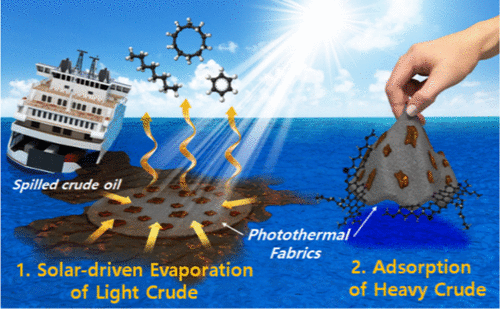当前位置:
X-MOL 学术
›
ACS Appl. Mater. Interfaces
›
论文详情
Our official English website, www.x-mol.net, welcomes your
feedback! (Note: you will need to create a separate account there.)
Photothermal Fabrics for Efficient Oil-Spill Remediation via Solar-Driven Evaporation Combined with Adsorption
ACS Applied Materials & Interfaces ( IF 8.3 ) Pub Date : 2021-03-15 , DOI: 10.1021/acsami.0c21656 Bon-Jun Ku 1 , Byoung-Min Lee 2 , Dong Hyun Kim 1 , Anush Mnoyan 1 , Sung-Kwon Hong 2 , Kang Seok Go 3 , Eun Hee Kwon 3 , Shin-Hyun Kim 4 , Jae-Hak Choi 2 , Kyubock Lee 1
ACS Applied Materials & Interfaces ( IF 8.3 ) Pub Date : 2021-03-15 , DOI: 10.1021/acsami.0c21656 Bon-Jun Ku 1 , Byoung-Min Lee 2 , Dong Hyun Kim 1 , Anush Mnoyan 1 , Sung-Kwon Hong 2 , Kang Seok Go 3 , Eun Hee Kwon 3 , Shin-Hyun Kim 4 , Jae-Hak Choi 2 , Kyubock Lee 1
Affiliation

|
Oil spill rapidly destroys aquatic system and threatens humans, requiring fast and efficient remedy for removal of oil. The conventional remedy employs water-floating oil adsorbents whose volume should be large enough to accommodate all oil ingredients. Here, we suggest a new concept for efficient oil-spill remediation, which combines solar-driven evaporation of light oil components and simultaneous adsorption of heavy oil components, namely, solar-driven evaporation of oil combined with adsorption (SEOA). To design photothermal oil absorbents for the efficient SEOA, we designed carbonaceous fabrics with high photothermal heating performance and oil-adsorption capacity by carbonizing nonwoven cotton fabrics. For three model organic solvents of octane, decane, and dodecane floating on water, the fabrics, respectively, accelerated the evaporation in factors of 2.0, 4.4, and 2.3 through photothermal heating under simulated sunlight condition. For the 1.18 mm thick crude oil floating on water, 70 and 77 wt % of crude oil were evaporated within 2 and 16 h, respectively, with the photothermal fabrics, whereas only 22 and 34 wt % was evaporated in the absence of the fabrics, indicating the dramatic enhancement of oil removal by solar-driven evaporation. The remaining heavy oil components were accommodated in the pores of the fabrics, removal of which showed an additional 18 wt % reduction; that is, a total 95 wt % of the crude oil was removed. The oil-treatment capacity is as high as 110 g g–1, which has never been achieved with conventional oil adsorbents to the best of our knowledge. We believe that our combinatorial SEOA approach potentially contributes to minimizing the environmental disaster through a fast and efficient oil-spill remediation.
中文翻译:

通过太阳能驱动蒸发与吸附相结合有效修复溢油的光热织物
漏油迅速破坏了水生系统并威胁着人类,需要快速有效的补救措施来清除油。常规疗法使用水浮油吸附剂,其体积应足够大以容纳所有油成分。在这里,我们提出了一种有效的溢油修复新概念,该概念结合了太阳能驱动的轻质油组分的蒸发和重油组分的同时吸附,即太阳能驱动的油质蒸发与吸附(SEOA)的结合。为了设计用于高效SEOA的光热吸油剂,我们通过将非织造棉织物碳化来设计具有高光热加热性能和吸油能力的碳质织物。对于分别漂浮在水上的辛烷,癸烷和十二烷这三种模型有机溶剂,织物 通过在模拟阳光条件下进行光热加热,以2.0、4.4和2.3的因子加速了蒸发。对于浮在水上的1.18毫米厚的原油,在使用光热织物的情况下,分别在2和16小时内蒸发了70和77 wt%的原油,而在没有织物的情况下,仅蒸发了22和34 wt%的原油,表明通过太阳能驱动的蒸发可以显着提高除油效果。剩余的重油成分被容纳在织物的孔中,去除这些油显示出另外的18 wt%的减少。即,去除了总计95重量%的原油。油处理能力高达110 gg 在光热织物的作用下,分别在2和16 h内蒸发了70和77 wt%的原油,而在不存在织物的情况下,仅蒸发了22和34 wt%的原油,这表明通过太阳能驱动的除油效果显着提高蒸发。剩余的重油成分被容纳在织物的孔中,去除这些油显示出另外的18 wt%的减少。即,去除了总计95重量%的原油。油处理能力高达110 gg 在光热织物的作用下,分别在2和16 h内蒸发了70和77 wt%的原油,而在不存在织物的情况下,仅蒸发了22和34 wt%的原油,这表明通过太阳能驱动的除油效果显着提高蒸发。剩余的重油成分被容纳在织物的孔中,去除这些油显示出另外的18 wt%的减少。即,去除了总计95重量%的原油。油处理能力高达110 gg 除去其显示出另外18wt%的减少;即,去除了总计95重量%的原油。油处理能力高达110 gg 除去其显示出另外18wt%的减少;即,去除了总计95重量%的原油。油处理能力高达110 gg据我们所知,–1是用传统的油吸附剂从未达到过的。我们认为,通过快速有效的溢油修复,我们的SEOA组合方法可能有助于最大程度地减少环境灾难。
更新日期:2021-03-24
中文翻译:

通过太阳能驱动蒸发与吸附相结合有效修复溢油的光热织物
漏油迅速破坏了水生系统并威胁着人类,需要快速有效的补救措施来清除油。常规疗法使用水浮油吸附剂,其体积应足够大以容纳所有油成分。在这里,我们提出了一种有效的溢油修复新概念,该概念结合了太阳能驱动的轻质油组分的蒸发和重油组分的同时吸附,即太阳能驱动的油质蒸发与吸附(SEOA)的结合。为了设计用于高效SEOA的光热吸油剂,我们通过将非织造棉织物碳化来设计具有高光热加热性能和吸油能力的碳质织物。对于分别漂浮在水上的辛烷,癸烷和十二烷这三种模型有机溶剂,织物 通过在模拟阳光条件下进行光热加热,以2.0、4.4和2.3的因子加速了蒸发。对于浮在水上的1.18毫米厚的原油,在使用光热织物的情况下,分别在2和16小时内蒸发了70和77 wt%的原油,而在没有织物的情况下,仅蒸发了22和34 wt%的原油,表明通过太阳能驱动的蒸发可以显着提高除油效果。剩余的重油成分被容纳在织物的孔中,去除这些油显示出另外的18 wt%的减少。即,去除了总计95重量%的原油。油处理能力高达110 gg 在光热织物的作用下,分别在2和16 h内蒸发了70和77 wt%的原油,而在不存在织物的情况下,仅蒸发了22和34 wt%的原油,这表明通过太阳能驱动的除油效果显着提高蒸发。剩余的重油成分被容纳在织物的孔中,去除这些油显示出另外的18 wt%的减少。即,去除了总计95重量%的原油。油处理能力高达110 gg 在光热织物的作用下,分别在2和16 h内蒸发了70和77 wt%的原油,而在不存在织物的情况下,仅蒸发了22和34 wt%的原油,这表明通过太阳能驱动的除油效果显着提高蒸发。剩余的重油成分被容纳在织物的孔中,去除这些油显示出另外的18 wt%的减少。即,去除了总计95重量%的原油。油处理能力高达110 gg 除去其显示出另外18wt%的减少;即,去除了总计95重量%的原油。油处理能力高达110 gg 除去其显示出另外18wt%的减少;即,去除了总计95重量%的原油。油处理能力高达110 gg据我们所知,–1是用传统的油吸附剂从未达到过的。我们认为,通过快速有效的溢油修复,我们的SEOA组合方法可能有助于最大程度地减少环境灾难。











































 京公网安备 11010802027423号
京公网安备 11010802027423号